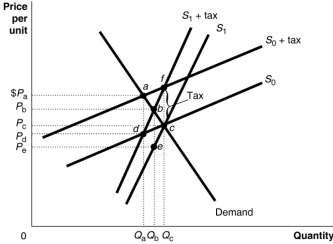Multiple Choice
Figure 16.2  Figure 16.2 shows a demand curve and two sets of supply curves, one set more elastic than the other.
Figure 16.2 shows a demand curve and two sets of supply curves, one set more elastic than the other.
-Refer to Figure 16.2.If the government imposes an excise tax of $1.00 on every unit sold, the government's revenue from the tax is represented by the area
A) (PaPc × Qa) if the supply curve is S0 and (PbPc × Qb) if the supply curve is S1.
B) (PaPd × Qa) if the supply curve is S0 and (PbPe × Qb) if the supply curve is S1.
C) (PaPe × Qa) under either supply curve.
D) (PbPe × Qb) under either supply curve.
Correct Answer:

Verified
Correct Answer:
Verified
Q31: For a given supply curve, the deadweight
Q51: What is a Lorenz curve and what
Q102: The person or firm that pays a
Q103: Which of the methods below would avoid
Q104: Figure 16.2 <img src="https://d2lvgg3v3hfg70.cloudfront.net/TB1015/.jpg" alt="Figure 16.2
Q105: Holding all other factors constant, income earned
Q106: The government of Coppersmith raises revenue through
Q108: Figure 16.1 <img src="https://d2lvgg3v3hfg70.cloudfront.net/TB1015/.jpg" alt="Figure 16.1
Q111: A Lorezo curve illustrates<br>A)a comparison of the
Q234: According to the ability-to-pay principle of taxation<br>A)individuals